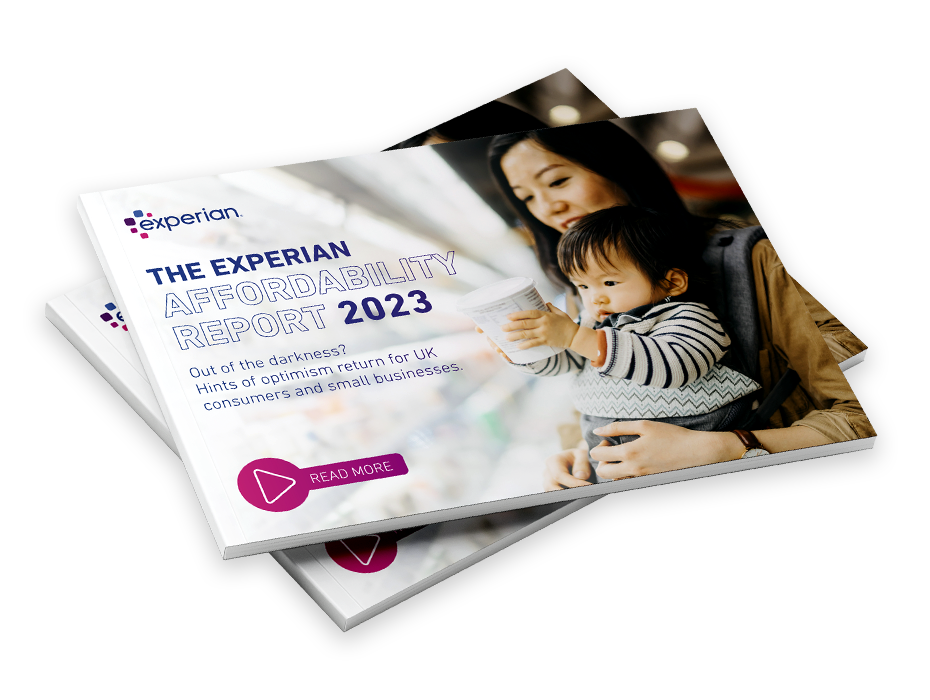Getting affordability decisions right in 2023
Accurately assessing affordability in 2023 can be difficult
A customer’s financial situation can quickly change, and there’s a renewed regulatory focus on the data and decisions being used to more accurately understand affordability.
Getting an accurate picture of what an individual can afford is getting more complex. Income and expenditure have become more volatile as consumers are buffeted by months of increasing inflation, rising interest rates and impact of the cost-of-living.
The FCA’s new Consumer Duty, in force from July 2023, sets out a benchmark for consumer outcomes which puts a renewed focus on the data being used by firms to assess an individual’s affordability.
How you navigate this challenging landscape and demonstrate that you’re meeting the demands of both the Regulator and consumers will be the key to your success.
The areas that you will need to focus on are:
- Verifying an individual’s income
- Understanding a customer’s essential expenditure and disposable income
- Monitoring an individual’s affordability to help deliver the best outcome
Key to this will be how you evidence that the data and processes you’re using are capable of addressing and mitigating foreseeable harm throughout your relationship with a consumer.
How is the economy affecting people’s affordability?
Organisations need to see the individual in more granular detail, both today and in the future, to avoid potential harm and secure the best outcomes.
Affordability depends on two factors: income and essential expenditure. Both are more difficult to verify or make reasonable assumptions about today, than in the past. Why?
We’re seeing more volatility in people’s income and expenditure. Inflation, the rise in interest rates and cost-of-living are buffeting consumers with a variety of consequences.
1. Income volatility and unpredictability
The UK looks set to avoid dipping into recession. Headline unemployment figures look relatively stable at historically low levels. But these top-line figures mask income shocks, a decline in many real-term incomes, individual changes in employment, different threat levels in different employment sectors, and other factors leading to complex volatility patterns in individual incomes.
2. Mortgage and housing shocks
In May, UK interest rates hit a 14-year high of 5%. This is the thirteenth consecutive rise in rates, bringing it to the highest since 2008. When interest rates rise, more than 1.4 million people on tracker and standard variable rate (SVR) deals usually see an immediate increase in their monthly payments. The rise from 4.5% to 5% means those on a typical tracker mortgage will pay about £47 more a month. Those on SVR mortgages face a £30 jump. Since December 2021, that’s an increase in monthly repayments of £465 on a tracker and £297 on an SVR.Three-quarters of mortgage customers hold a fixed-rate mortgage. Their monthly payments may not change immediately, but house buyers – or anyone seeking to re-mortgage, estimated to be 1.8 million people this year – will have to pay a lot more now than if they had taken out the same mortgage a year or more ago. The Bank of England estimates that four million households will face higher rates in 2023[1], whether through higher variable rates or borrowers renegotiating fixed-rate deals. These increased costs will also flow through into higher rental prices as landlords look to cover rising financing costs.
3. The cost-of-living crisis and high inflation
The annual rate of inflation has remained stubbornly stuck at 8.7%[2]. Whilst inflation has fallen slightly the cost of consumers’ core expenditure for essentials such as food and fuel have remained higher and less predictable than a year ago, with more risk of consumer detriment from credit commitments.
How are consumers responding?
Experian research conducted in May provides further insight on how consumers are responding to increases in the cost-of-living.
- Seven out of ten consumers (69%) say it significantly impacts their finances.
- More than half of those in employment (58%) say their income cannot keep up with the rising cost of living.
- Only 30% say they feel financially secure.
This squeeze – and the unease that comes with it – is changing spending patterns.
- 82% of consumers say they are more conscious of their spending this year, and 37% have changed how they travel or commute to save money.
- More than half are spending less on eating and drinking out (55%), clothes (55%) and events (53%).
- A quarter of consumers (26%) say they don’t know how they would cover a sudden cost of £2,500, and only one in five (22%) would be able to find that sum in cash.
- Having to spend more to cover necessities, almost half of consumers (45%) are saving less than before.
By contrast, non-disposable spending is rising for almost all.
- Household bills have increased for 71% of people and groceries for 61%.
- It is reasonable to assume that those who have yet to see higher costs in these areas have reduced consumption or are dipping into savings to supplement their income.
What emerges is a complex picture of pressures and individual responses.

How does the FCA’s Consumer Duty change affordability?
In the FCA’s words, the Consumer Duty marks a “significant shift in our expectations of firms”[3]. It:
- holds Financial Services firms to higher standards when it comes to achieving good customer outcomes and avoiding harm
- introduces “a more outcomes-focused approach to consumer protection”[4]
- places an emphasis on firms identifying and mitigating foreseeable harm
The FCA’s 2022 letter to CEOs in the credit industry identified “inadequate affordability assessment”[5] as a critical potential cause of harm.
Consequently, best practice in affordability is changing. Affordability assessments are nothing new, but the increased regulatory focus means that.
- Consumers need to be treated as individuals, and assessments based on modelled averages from sources such as ONS are increasingly unsuitable.
- Historic affordability assessments when offering customers new or enhanced products (up-selling and cross-selling) are unreliable and often out of date.
Affordability needs to be monitored throughout the relationship with the customer not just when they apply for credit, to ensure the credit is still affordable and a consumer isn’t put in detriment. Identifying changes in affordability and potential vulnerabilities puts a new emphasis on the need to monitor changes to an individual’s finances.
How can you respond?
Firms need to more accurately monitor volatility, verify income and identify changes to an individual’s affordability.
- Assessing income. In a turbulent economic climate, it’s no longer safe to assume that a consumer’s income will stay stable (or increase) over the duration of a loan. Although widely reported to be rising, wage increases are not keeping up with price inflation – in many cases, real incomes are falling. Organisations need to understand more about the source and security of a consumer’s income to make the right decisions. Verify an applicant’s declared income, determine if a consumer has sufficient income to manage new lending and recognise recent changes in income.
- Assessing non-discretionary expenditure. Cost-of-living pressures mean consumers’ discretionary spending is being squeezed. An affordable product or service two years ago may well be less so now. You need to develop a better-informed view of an individual’s expenditure, determine their monthly discretionary spend using household composition to create a better apportionment of household bills so you can make the best affordability assessments and meet your duty of care.
- Continuous, ‘always on’ affordability monitoring. Increasing uncertainty amongst consumers to be able to cover the cost of a loan, puts renewed pressure on firms to monitor affordability. Being able to continuously monitor affordability throughout your customer relationship is essential to identify risk and emerging vulnerability. Identifying consumers with low financial resilience, recognising changes in income and knowing when a consumer’s current account balance is reducing, or they’re regularly using an overdraft to-make-ends meet is essential for you to drive better consumer outcomes.
Helping you meet the affordability challenge – Affordability IQ
In response to the need to more accurately monitor volatility and identify changes to a consumer’s affordability, Experian has updated and improved – it’s bureau Affordability IQ insights, making improvements in three areas:
- Income verification. Verify an applicant’s declared income, determine if a consumer has sufficient income to manage new lending and recognise recent changes in income using our latest bureau-based income data
- Non-discretionary expenditure. Develop a better-informed view of an individual’s expenditure by using Experian’s actual figures for core spending on key characteristics such energy costs, mortgages and Council Tax.
- Affordability monitoring. Monitor affordability through-out your relationship with a customer to drive better outcomes. Identify consumers with low financial resilience, recognise changes in income and know when a consumer’s current account balance is reducing, or they’re regularly using an overdraft to manage their finances
How can we help?
Affordability IQ is part of a suite of complementary Experian Affordability products that can be used in association with each other to drive better consumer outcomes. They also include:
- Work Report – verified income and employment data sourced directly from an employer’s payroll with a consumer’s consent to verify gross and net income, as well as source of income.
- Affordability Passport– detailed analysis of an individual or households regular and irregular income, as well as categorised spend taken with their consent directly from their online bank account using Open Banking.
- Categorisation as a Service – on-the-cloud categorisation and analysis on an individual’s income and current account spend to provide on-going monitoring of affordability, current account balance and use of overdraft to organisations with large portfolios of current account customers.
Together, these improvements can help you access a reliable view of a consumer – today and throughout the credit lifecycle – and help you meet your duty of care.
Read our latest research
We explore how the past few challenging years have impacted perceptions of financial stability and affordability.
Download now[1] How are the rising cost of living and interest rates affecting households’ ability to pay their mortgage?, Bank of England
[2] Consumer price inflation, UK: February 2023, Office for National Statistics
[3] Implementing the Consumer Duty in the General Insurance and Pure Protection sectors, Financial Conduct Authority
[4] FCA supports firms through the transition to implementing the Consumer Duty, Financial Conduct Authority
[5] Implementing the Consumer Duty in Mainstream Consumer Credit Lenders (MCCL), Financial Conduct Authority










